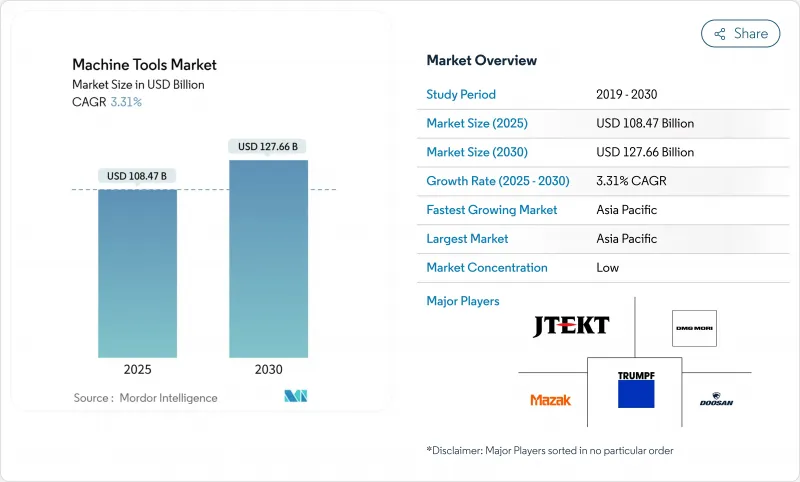
|
市場調査レポート
商品コード
1851056
工作機械:市場シェア分析、産業動向、統計、成長予測(2025年~2030年)Machine Tools - Market Share Analysis, Industry Trends & Statistics, Growth Forecasts (2025 - 2030) |
||||||
カスタマイズ可能
適宜更新あり
|
|||||||
| 工作機械:市場シェア分析、産業動向、統計、成長予測(2025年~2030年) |
|
出版日: 2025年06月23日
発行: Mordor Intelligence
ページ情報: 英文 150 Pages
納期: 2~3営業日
|
概要
工作機械市場の2025年の市場規模は1,084億7,000万米ドルで、2030年には1,276億6,000万米ドルに達し、CAGR 3.31%で成長すると予測されています。

この市場拡大は、サプライチェーンの再編、貿易ルールの厳格化、半導体工場への記録的な投資を背景としており、各工場で超精密加工能力が求められています。1台4億米ドル以上するASMLのHigh-NA EUVシステムは、次世代リソグラフィがナノメートルレベルの金属切断と仕上げの性能水準をいかに引き上げているかを例証しています。また、インダストリー4.0プロジェクトでは、送り速度とツールパスを自己最適化するAI対応CNC制御を搭載するケースが増えています。地域別の投資パターンでは、アジアが生産能力増強の大半を占めるが、米国ではリショアリングのインセンティブがあり、欧州では関税の不確実性があるため、将来の需要はより多様な工場に傾きつつあります。直販は依然として世界の流通の大半を占めているが、eコマース・ポータルは、中間価格帯のCNCモデルや交換用工具の調達サイクルを加速させています。
世界の工作機械市場の動向と洞察
電動化の波が精密e-パワートレイン加工を牽引
電気自動車用モーター工場では、公差をマイクロスケールの範囲に押し上げ、自動化されたステーター挿入やヘアピン巻線と、二次仕上げ工程を排除する5軸マシニングセンターを組み合わせることが多いです。ゼット・エフ社は2030年までにEVドライブトレインラインの70%自動化を目標としており、中国のサプライヤーは2034年までに年間生産量が1億2,000万台を超えると予測しています。ゼネラル・モーターズとメルセデス・ベンツは、eモーター・ハウジングの生産をインソーシングしており、パスオフ・ビビリが発生することなくアルミ・シリコン合金を切削するマシンを好んで使用しています。インプロセス・ゲージング、クーラント管理、ミクロン・レベルの形状誤差から発生する電磁ノイズを抑制するためのクローズド・ループ補正への需要が高まっています。
超精密装置を必要とする半導体工場の拡大
世界の300mmファブへの投資額は2027年に1,370億米ドルに達すると予測されており、南北アメリカでは3年間で投資額が倍増します。ASMLの数トン投影光学系は、1mの移動で50nm以下の形状誤差を保持するダイヤモンド旋盤とエアベアリング研削システムを必要とします。TSMCの1,650億米ドルのアリゾナ複合施設は、主権チップ・プログラムが、組立中に重い部品を国内に維持することができる超精密機械加工工場にとって、どのようにローカル・プルを生み出すかを例証しています。クリーンルーム適合性、静圧スライドウェイ、コンタミネーションフリーの潤滑方式は、現在、このニッチにサービスを提供する装置メーカーの基本仕様となっています。
高度なCNCシステムには高い設備投資と長い投資回収期間が必要
アトランタ連銀の調査によると、製造業者の80%が、資本設備に着手する前に金利を重要視しており、この傾向は2025年のプライムレート上昇によって増幅されます。最高級の5軸セルを導入すると300万米ドルを超えることもあり、中規模の加工工場では損益分岐点が5年を超えます。暫定的なソリューションとして、機器のアズ・ア・サービス契約が浮上しているが、多くのCFOは、ソフトウェアのアップグレードによって初期世代のコントローラーが時代遅れになった場合の残存価値リスクを警戒しています。
セグメント分析
多軸セグメントは、2025年の工作機械市場規模のうち246億米ドルを占め、2030年までのCAGRは7.00%です。フライス盤は2024年に28.23%のシェアで最大の収益を維持するが、現在は複雑なハウジングをワンクランプで仕上げる同時5軸プラットフォームに成長が集中しています。自動車メーカーは、ICEシリンダーブロックラインをe-driveケーシングセルに置き換え、フロアスペースとハンドリングコストを削減するために多軸機を採用します。航空宇宙産業のプライムは、高トルクのチルトスピンドルセンターを追加して、1.2 mの長さで0.015 mmの平坦度を維持しながらチタンスパーをフライス加工しています。ツールルームのオペレータは、依然として3軸ニーミルに依存していますが、デジタル表示カウンタとプロービングを備えたレトロフィットキットにより、保守作業での競争力を維持しています。
レーザー切断システムの需要は、AIガイドのパラメーターウィザードが薄板ステンレスのスクラップ率を削減するため、回復しています。放電加工は、ミルが経済的に到達できない微小コーナー半径を必要とする工具と金型のキャビティでニッチを維持しています。指向性エネルギー堆積法と仕上げフライス加工をミックスしたハイブリッドマシンは、サイクルタイム短縮が装置コストを上回るプロトタイプラボに導入されています。プラズマプラットフォームとウォータージェットプラットフォームは、重加工ヤードを対象としているが、反った板材の切断品質を維持するために、クローズドループ高さ制御を統合し始めています。
CNCプラットフォームは、2024年の売上高の68.98%を占め、CAGR 6.20%で上昇し、工作機械市場の中心的地位を固める。新興のコントローラは、STEPファイルを最適化されたツールパスに直接変換するGPU加速アルゴリズムを採用しており、短納期部品のプログラミング時間を短縮します。中国のFirst Automation社は、サーボドライブとPLCスタックをローカライズするために約1億人民元を確保し、海外ファームウェア依存のリスクを回避する戦略的取り組みを強調しました。従来型の手動機械は、小規模な作業場や職業訓練校で存続しているが、将来的な改修を見越し、制御装置なしで購入した場合でも、新しい機械はサーボ対応フレームに移行する傾向にあります。ハイブリッドアディティブサブトラクティブシステムが最先端を占め、レーザー金属成膜と5軸フライス加工を組み合わせることで、航空宇宙用ブラケットのサポート構造除去ステップを排除しています。
デジタルツインシステムは、工具のたわみと熱ドリフトをシミュレートし、ファーストアーティクルの実行中の衝突を防ぐオフマシン検証を可能にします。ChatCNC(TM)プラグインは、プリズム形状を認識し、荒加工から仕上げ加工までのシーケンスを自動生成するため、経験の浅いプログラマでもベテランレベルのサイクルタイムを実現できます。予測分析プラットフォームは、致命的な故障が発生する前に、スピンドルの異常にフラグを立てます。
工作機械市場レポートは、製品別(金属切削工具、金属成形工具)、技術別(従来型機械、CNC機械、その他)、エンドユーザー産業別(自動車、航空宇宙・防衛、その他)、販売チャネル別(直販、その他)、地域別(北米、アジア太平洋、欧州、その他)に分類されています。本レポートでは、上記すべてのセグメントについて、市場規模および市場予測(米ドル)を提供しています。
地域別分析
アジア太平洋地域が戦略転換の中でリード、北米は回復、欧州は逆風の中でイノベーションを推進アジア太平洋地域は2025年に世界売上高の45.43%を占め、CAGRは6.20%となる見通し。中国は、迫り来る中級機に対する25%の米国関税を相殺するため、少量生産工場をハイエンドのCNCセル工場にアップグレードしています。インドの生産連動型奨励金制度は、資本を300mmウエハー工場と防衛機体製造に誘導し、精密水平盤と立形マシニングセンタの受注を生み出しています。日本は数十年にわたるモーションコントロールのノウハウを活用し、複数シフトのデューティサイクルでサブミクロンの繰り返し精度を維持する超精密研削盤を輸出し、韓国の家電コングロマリットは折りたたみ式携帯電話のヒンジプレートやカメラモジュールの加工能力に投資しています。ベトナムやタイなどのASEAN諸国は、OEMが地理的リスクの分散を重視するチャイナプラスワンソーシングモデルを採用するにつれてシェアを拡大しています。
北米は、戦略的製造業の自立再建を目指したリショアリング政策の恩恵を受ける。米国の消費は、地域の工具メーカーが宇宙打ち上げ構造物に使用される大型立旋盤の生産能力を増強したため、2001年以来最高の11.9%のシェアに達しました。メキシコの9.1%増は、ヌエボ・レオンにある州が支援する工業団地が24時間許可承認を提供するニアショア自動車組立に起因します。カナダは、鉱業部門と低炭素エネルギー・プロジェクトから工作機械の受注を獲得しているが、全体的な勢いは、大陸全体に共通する制約である熟練労働者不足によって抑えられています。
欧州は、電気料金の高騰と為替変動によるマージンの悪化に直面しているが、高精度5軸加工機とレーザー金属成膜装置では圧倒的なリードを保っています。ドイツのメーカーは、48時間の納期を保証するスピンドル交換プログラムなど、アフターセールス契約やレトロフィットを推進することで、軟調な国内受注に対応しています。トルンプは2025年に5億3,000万ユーロを研究開発に投資し、売上高が9%減少したにもかかわらず、ビームソースの効率で優位性を維持した。北欧企業は、新機械出荷のたびにカーボンフットプリント証明書を提供することで、持続可能性のリーダーシップを強調しています。
その他の特典:
- エクセル形式の市場予測(ME)シート
- 3ヶ月間のアナリストサポート
よくあるご質問
目次
第1章 イントロダクション
- 調査の前提条件と市場の定義
- 調査範囲
第2章 調査手法
第3章 エグゼクティブサマリー
第4章 市場情勢
- 市場概要
- 市場促進要因
- 高精度e-パワートレイン加工を牽引する電動化の波
- インダストリー4.0の採用がスマートCNCプラットフォームの需要を押し上げる
- 高速多軸工具を必要とする軽量合金と複合材の普及
- 超精密装置を必要とする半導体工場の拡大
- 老朽化(20年以上)した工作機械フリートの世界の買い替えサイクル
- フレキシブル加工による多品種・少量生産の自動化
- 市場抑制要因
- 特殊鋼とリニアモーションコンポーネントのコスト高騰
- 高度なCNCシステムには高い設備投資と長い投資回収期間が必要
- 熟練CNCプログラマー/オペレーターの世界的不足
- 付加製造技術への資本投入
- バリュー/サプライチェーン分析
- 規制の展望(主要な政府規制とイニシアチブ)
- 技術スナップショット
- コネクテッド&オートメーションマシン
- 高度制御/ モーションシステム
- デジタル化とインダストリー4.0
- AIによる金属切削精度の向上
- 金属加工業界のスナップショット
- 地政学が工作機械市場に与える影響
- 業界の魅力- ファイブフォース分析
- 供給企業の交渉力
- 買い手の交渉力
- 新規参入業者の脅威
- 代替品の脅威
- 競争企業間の敵対関係
第5章 市場規模と成長予測
- 製品別
- 金属切削工具
- フライス盤
- ドリルマシン
- 旋盤
- 研削盤
- レーザー切断機
- 放電加工機(EDM)
- ウォータージェット切断機
- プラズマ切断機
- 多軸マシニングセンタ
- その他(ボーリングなど)
- 金属成形工具
- プレス(機械式、油圧式、サーボ式)
- 鍛造機械
- ベンディングマシン
- その他(シャーリング、押出、圧延など)
- 金属切削工具
- 技術別
- 従来型マシン(手動または半手動)
- CNCマシン
- 積層造形/ハイブリッドマシン
- エンドユーザー業界別
- 自動車
- 航空宇宙・防衛
- 電気・電子
- 産業機械・設備
- 医療機器
- 造船・海洋
- 精密エンジニアリング
- エネルギー・電力
- 金属加工(ジョブショップなど)
- その他の産業(鉄道、その他一般製造業など)
- 販売チャネル別
- 直接販売(OEMからエンドユーザー)
- ディーラー&ディストリビューター
- オンライン/eコマース
- その他(システムインテグレーター、イベント&展示会、リビルダー&再生品など)
- 地域別
- 北米
- 米国
- カナダ
- メキシコ
- 南米
- ブラジル
- アルゼンチン
- ペルー
- その他南米
- 欧州
- 英国
- ドイツ
- フランス
- イタリア
- スペイン
- ベネルクス(ベルギー、オランダ、ルクセンブルク)
- ノルディックス(デンマーク、フィンランド、アイスランド、ノルウェー、スウェーデン)
- その他欧州地域
- アジア太平洋地域
- 中国
- インド
- 日本
- オーストラリア
- 韓国
- ASEAN(インドネシア,タイ,フィリピン,マレーシア,ベトナム)
- その他アジア太平洋地域
- 中東・アフリカ
- サウジアラビア
- アラブ首長国連邦
- カタール
- クウェート
- トルコ
- エジプト
- 南アフリカ
- ナイジェリア
- その他中東・アフリカ地域
- 北米
第6章 競合情勢
- 市場集中度
- 戦略的動向
- 市場シェア分析
- 企業プロファイル
- Yamazaki Mazak Corporation
- DMG MORI Co. Ltd
- TRUMPF Group
- JTEKT Corporation
- Doosan Machine Tools
- Okuma Corporation
- Makino Milling Machine Co. Ltd
- Haas Automation Inc.
- FANUC Corporation
- Hyundai Wia Corp.
- Schuler AG
- Sandvik AB(Seco & Walter)
- GF Machining Solutions
- Fives Group
- GROB-Werke GmbH & Co. KG
- Hermle AG
- EMAG GmbH & Co. KG
- Hardinge Inc.
- HURCO Companies Inc.
- Amada Co. Ltd

